Serving 493 students in grades Kindergarten-6, Ocean Air ranks in the top 1% of all schools in California for overall test scores (math proficiency is top 1%, and reading proficiency is top 1%).
The percentage of students achieving proficiency in math is 92% (which is higher than the California state average of 33%). The percentage of students achieving proficiency in reading/language arts is 94% (which is higher than the California state average of 47%).
The student:teacher ratio of 21:1 is equal to the California state level of 21:1.
Minority enrollment is 67% of the student body (majority Asian), which is lower than the California state average of 80% (majority Hispanic).
Quick Stats (2025)
- Grades: Kindergarten-6
- Enrollment: 493 students
- Student:Teacher Ratio: 21:1
- Minority Enrollment: 67%
- Overall Testing Rank: Top 1% in CA
- Math Proficiency: 92% (Top 1%)
- Reading Proficiency: 94% (Top 1%)
- Science Proficiency: 75-79% (Top 1%)
- Source: National Center for Education Statistics (NCES), CA Dept. of Education
Top Rankings
Ocean Air ranks among the top 20% of public schools in California for:
Category
Attribute
Overall Rank
Math Proficiency
Reading/Language Arts Proficiency
Science Proficiency
School Overview
Ocean Air's student population of 493 students has declined by 22% over five school years.
The teacher population of 23 teachers has declined by 14% over five school years.
Grades Offered
Grades Kindergarten-6
Total Students
493 students

Gender %
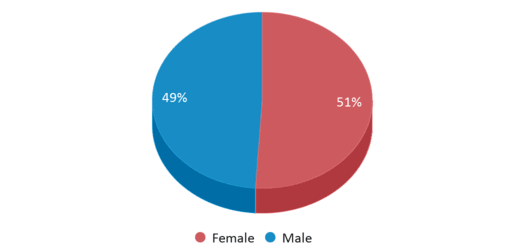
Total Classroom Teachers
23 teachers
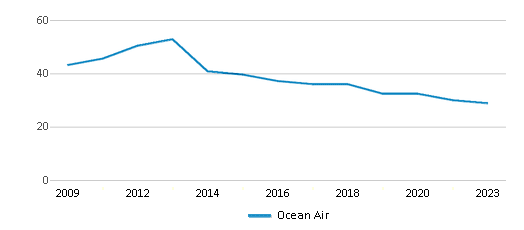
Students by Grade

School Calendar
School Rankings
Ocean Air ranks within the top 1% of all 9,602 schools in California (based off of combined math and reading proficiency testing data).
The diversity score of Ocean Air is 0.66, which is more than the diversity score at state average of 0.63. The school's diversity has stayed relatively flat over five school years.
Overall Testing Rank
#15 out of 9602 schools
(Top 1%)
(Top 1%)

Math Test Scores (% Proficient)
92%
33%

Reading/Language Arts Test Scores (% Proficient)
94%
47%

Science Test Scores (% Proficient)
75-79%
29%
Student : Teacher Ratio
21:1
21:1

American Indian
n/a
1%
Asian
47%
12%

Hispanic
8%
56%

Black
1%
5%

White
33%
20%

Hawaiian
1%
n/a

Two or more races
10%
6%
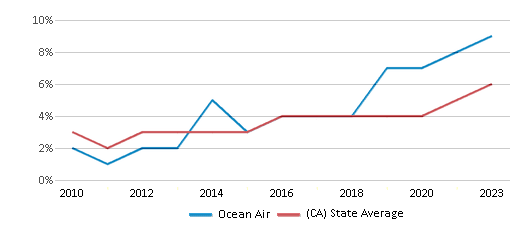
All Ethnic Groups

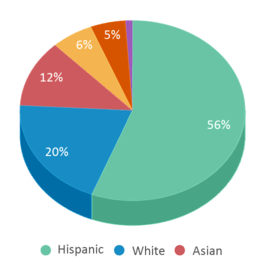

Eligible for Free Lunch
3%
54%

Eligible for Reduced Lunch (13-14)
1%
9%
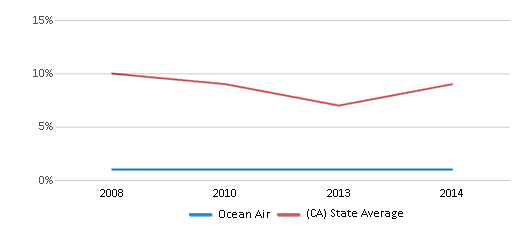
School Statewide Testing
School District Name
Source: National Center for Education Statistics (NCES), CA Dept. of Education
Profile last updated: 02/09/2025
Frequently Asked Questions
What is Ocean Air's ranking?
Ocean Air is ranked #15 out of 9,602 schools, which ranks it among the top 1% of public schools in California.
What schools are Ocean Air often compared to?
Ocean Airis often viewed alongside schools like Sage Canyon, Torrey Hills by visitors of our site.
What percent of students have achieved state testing proficiency in math and reading?
92% of students have achieved math proficiency (compared to the 33% CA state average), while 94% of students have achieved reading proficiency (compared to the 47% CA state average).
How many students attend Ocean Air?
493 students attend Ocean Air.
What is the racial composition of the student body?
47% of Ocean Air students are Asian, 33% of students are White, 10% of students are Two or more races, 8% of students are Hispanic, 1% of students are Black, and 1% of students are Hawaiian.
What is the student:teacher ratio of Ocean Air?
Ocean Air has a student ration of 21:1, which is equal to the California state average of 21:1.
What grades does Ocean Air offer ?
Ocean Air offers enrollment in grades Kindergarten-6
What school district is Ocean Air part of?
Ocean Air is part of Del Mar Union Elementary School District.
In what neighborhood is Ocean Air located?
Ocean Air is located in the Carmel Valley neighborhood of San Diego, CA. There are 8 other public schools located in Carmel Valley.
School Reviews
3 1/20/2020
It's an awesome school with a great principal. The school is very safe, fun, and has great teachers. The school is kept clean, and there is no bullying. If anything goes wrong in Ocean Air, the school confronts it and takes action. The school is well rounded: We have steam classes. Science, Music, P.E, Enrichment, Technology, Art, and more classes are at Ocean Air. Not only that, but Ocean Air feels like home. Every new student feels like they belong here. The students are very nice, and it's a very diverse school. Children from all races are welcome. Overall, It's a great school. I went to Ocean Air, and I enjoyed it. I feel like the school helped me to prepare for middle school. I highly recommend Ocean Air, and It's an awesome school!!
5 5/30/2011
Ocean Air is a great school. Unlike some other schools, we still have all our ESC classes (music, art, P.E., science, technology, and library) even with budget cuts. We have GATE programs, award ceremonies, and many clubs, like Art Club, Garden Club, Drama Club, Zoo Crew, and more. Parents are very involved and support Ocean Air. It's an awesome school!
Review Ocean Air. Reviews should be a few sentences in length. Please include any comments on:
- Quality of academic programs, teachers, and facilities
- Availability of music, art, sports and other extracurricular activities
Recent Articles

What Is A Charter School?
Explore the world of charter schools in this comprehensive guide. Learn about their history, how they operate, and the pros and cons of this educational innovation. Discover key facts about charter schools, including admission policies, demographics, and funding, as well as what to look for when considering a charter school for your child.

10 Reasons Why High School Sports Benefit Students
Discover the 10 compelling reasons why high school sports are beneficial for students. This comprehensive article explores how athletics enhance academic performance, foster personal growth, and develop crucial life skills. From improved fitness and time management to leadership development and community representation, learn why participating in high school sports can be a game-changer for students' overall success and well-being.

February 05, 2025
Understanding the U.S. Department of Education: Structure, Impact, and EvolutionWe explore how the Department of Education shapes American education, from its cabinet-level leadership to its impact on millions of students, written for general audiences seeking clarity on this vital institution.









